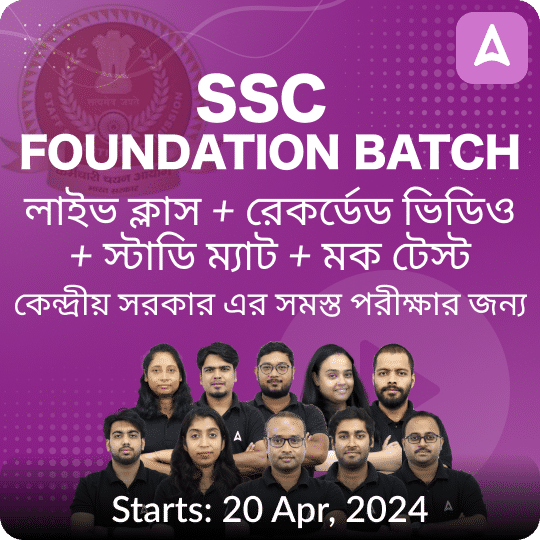Q1. নিম্নলিখিত বিবৃতি বিবেচনা করুন
- যখন কোনও স্টেট বিল রাষ্ট্রপতির জন্য সংরক্ষিত থাকে, তখন তাকে তার সম্মতি জানাতে বাধ্য করা হয় না তবে একই সাথে তিনি বিলটিও ফিরিয়ে দিতে পারবেন না।
- বিলের “পাবলিক ইন্টারেস্ট ” থাকলেও রাজ্যের গভর্নর তার সম্মতি জানাতে বাধ্য নন।
উপরোক্ত বিবৃতিগুলির মধ্যে কোনটি সঠিক /কোনগুলি সঠিক?
(a) কেবল 1
(b) কেবল 2
(c) 1 এবং 2 উভয়ই
(d) 1 বা 2 কোনোটিই নয়
Q2. ভারতে, নিম্নলিখিতগুলির মধ্যে কোনটির অধীনে ইন্টারনেট পরিষেবা নিষিদ্ধ করা যেতে পারে ?
(a) তথ্য প্রযুক্তি আইন, 2000
(b) নাগরিক কার্যবিধি কোড, 1973
(c) টেলিগ্রাফ আইন, 1885
(d) উভয় (a) এবং (c)
Q3. রাষ্ট্রপতি নির্বাচনী কলেজ নিয়ে গঠিত
- লোকসভা এবং রাজ্যসভার সমস্ত সদস্য
- রাজ্য বিধান সভা ও বিধান পরিষদের সকল সদস্য
- দিল্লি এবং পন্ডিচেরির বিধানসভা সমস্ত সদস্য
উপরোক্ত বিবৃতিগুলির মধ্যে কোনটি সঠিক / কোনগুলি সঠিক?
(a) 1 এবং 2
(b) 2 এবং 3
(c) 1, 2, 3
(d) কোনটিই নয়
Q4. নিম্নলিখিত বিবৃতি বিবেচনা করুন
- সংসদীয় আইন, 1951 সালের আরপিএ অনুসারে, সরকারি চুক্তি, কাজ বা পরিষেবাগুলিতে আগ্রহী সংসদ সদস্য ও বিধায়কদের অযোগ্যতার ভিত্তি হিসাবে বিবেচিত হবে না।
- সংবিধানের 191 আর্টিকেলে একটি লোকসভার সদস্যের সদস্যপদের জন্য অযোগ্য ঘোষণা করে
উপরোক্ত বিবৃতিগুলির মধ্যে কোনটি সঠিক /কোনগুলি সঠিক?
(a) কেবল 1
(b) কেবল 2
(c) 1 এবং 2 উভয়ই
(d) 1 বা 2 কোনোটিই নয়
Q5. অফিস অফ হুইপ সম্পর্কিত নিম্নলিখিত বিবৃতি বিবেচনা করুন
- ‘হুইপ’ এর কার্যালয়টি ভারতের সংবিধানে উল্লেখ করা হয়নি তবে হাউসের বিধিবিধানে উল্লিখিত হয়েছে।
- সদস্যদের হুইপ প্রদত্ত নির্দেশনা অনুসরণ করার কথা রয়েছে। তা না হলে শাস্তিমূলক ব্যবস্থা নেওয়া যেতে পারে।
উপরোক্ত বিবৃতিগুলির মধ্যে কোনটি সঠিক / কোনগুলি সঠিক?
(a)কেবল 1
(b) কেবল 2
(c) 1 এবং 2 উভয়ই
(d) 1 বা 2 কোনোটিই নয়
Q6. কমিটির নিম্নলিখিত কোন সদস্য ভারতের কেন্দ্রীয় তথ্য কমিশন নির্বাচন করে
- প্রধানমন্ত্রী
- আইন মন্ত্রিপরিষদ মন্ত্রী
- লোকসভায় বিরোধী দলনেতা
- ভারতের প্রধান বিচারপতি
নীচে থেকে সঠিক কোডটি নির্বাচন করুন:
(a) 1, 2, 4,
(b) 2, 3, 4
(c) 1, 3
(d) 1, 3, 4
Q7. জিরো আওয়ার সম্পর্কিত নিম্নলিখিত বিবৃতিগুলি বিবেচনা করুন
- সংসদ সদস্যদের পূর্বের নোটিশ দিয়ে বিষয়টি উত্থাপন করার জন্য এটি একটি অনানুষ্ঠানিক যন্ত্র
- জিরো আওয়ার কোশ্চেন আওয়ারের পরেই সাথে সাথে শুরু হয় এবং দিনের এজেন্ডা পর্যন্ত স্থায়ী হয়
উপরোক্ত বিবৃতিগুলির মধ্যে কোনটি সঠিক /কোনগুলি সঠিক?
(a) শুধুমাত্র 1
(b) কেবল 2
(c) 1 এবং 2 উভয়ই
(d) 1 বা 2 কোনোটিই নয়
Q8. এটি কোনও সদস্যের দ্বারা গৃহীত একটি প্রস্তাব যা কোনও বিষয়টি নিয়ে বিতর্কটি সংক্ষিপ্ত করে রাখে। প্রস্তাবটি যদি হাউস দ্বারা অনুমোদিত হয়, তাত্ক্ষণিক তর্কটি বন্ধ হয়ে যায় এবং বিষয়টি ভোট দেওয়ার জন্য রাখা হয়। এটা-
(a) কলিং এটেনশন মোশন
(b) ক্লোসার মোশন
(c) সেন্সর মোশন
(d) পলিসি কাট মোশন
Q9. কলিং এটেনশন মোশন সম্পর্কিত নিম্নলিখিত বিবৃতি বিবেচনা করুন
- জনসাধারণের কাছে জরুরি জনসাধারণের গুরুত্বের বিষয়ে একজন মন্ত্রীর দৃষ্টি আকর্ষণ করার জন্য একজন সদস্য সংসদে এটি চালু হয়েছিল।
- এটি সংসদীয় পদ্ধতিতে একটি ভারতীয় উদ্ভাবন এবং 1985 সাল থেকে এটি বিদ্যমান
উপরোক্ত বিবৃতিগুলির মধ্যে কোনটি সঠিক / কোনগুলি সঠিক?
(a) কেবল 1
(b) কেবল 2
(c) 1 এবং 2 উভয়ই
(d) 1 বা 2 কোনোটিই নয়
Q10. নিম্নলিখিত বিবৃতি বিবেচনা করুন
- মন্ত্রিপরিষদকে সরিয়ে দেওয়ার এবং সরকারকে ক্ষমতাচ্যুত করার জন্য নো কনফিডেন্স মোশন গৃহীত হয়েছে।
- সংসদের যে কোনও সভায় নো কনফিডেন্স মোশন উত্থাপন করা যেতে পারে
- লোকসভায় বা রাজ্য বিধানসভায় একটি সেন্সর মোশন উত্থাপন করা যেতে পারে।
উপরোক্ত বিবৃতিগুলির মধ্যে কোনটি সঠিক /কোনগুলি সঠিক?
(a) 1 এবং 2
(b) 2 এবং 3
(c) 1, 2, 3
(d) 1, 3
Solutions
S1.Ans.(b)
Sol.
When a state bill is reserved for the President, he is not forced to give his assent but at the same time, he can also return the bill.
When the bill is in “public interest”, then also the governor of the state is not bound to give his assent.
S2.Ans.(d)
Sol.
The suspension of internet services is dealt with under Information Technology Act, 2000 Criminal Procedure Code, 1973 and Telegraph Act, 1885.
S3.Ans.(d)
Sol.
The President is elected not directly by the people but by members of Electoral College consisting of · the elected members of both the Houses of Parliament; · the elected members of the legislative assemblies of the states; and · the elected members of the legislative assemblies of the Union Territories of Delhi and Puducherry.
S4.Ans.(b)
Sol.
Article 191 of the Constitution provides a disqualification for membership of a legislative assembly or legislative council of a state. Hence, the provisions of their disqualification are mentioned in the constitution.
Taking interest in government contracts, works or services is considered a ground for disqualification of MPs and MLAs as per RPA, 1951 made by Parliament
S5.Ans.(b)
Sol.
Whip Though the offices of the leader of the House and the leader of the Opposition are not mentioned in the Constitution of India, they are mentioned in the Rules of the House and Parliamentary Statute respectively. The office of ‘whip’, on the other hand, is mentioned neither in the Constitution of India nor in the Rules of the House nor in a Parliamentary Statute. It is based on the conventions of the parliamentary government. Every political party, whether ruling or Opposition, has its own whip in the Parliament. He is appointed by the political party to serve as an assistant floor leader. He is charged with the responsibility of ensuring the attendance of his party members in large numbers and securing their support in favour of or against a particular issue. He regulates and monitors their behaviour in the Parliament. The members are supposed to follow the directives given by the whip. Otherwise, disciplinary action can be taken.
S6.Ans.(d)
Sol.
section 12(3) of the RTI Act 2005 provides that a three-member committee for the appointment of the members of the information commission. These are as follows:
(i) The Prime Minister, who shall be the Chairperson of the committee;
(ii) The Leader of Opposition in the Lok Sabha and
(iii) A Union Cabinet Minister to be nominated by the Prime Minister.
S7.Ans.(b)
Sol.
Zero Hour Unlike the question hour, the zero hour is not mentioned in the Rules of Procedure. Thus it is an informal device available to the members of the Parliament to raise matters without any prior notice. The zero hour starts immediately after the question hour and lasts until the agenda for the day (ie, regular business of the House) is taken up. In other words, the time gap between the question hour and the agenda is known as zero hour. It is an Indian innovation in the field of parliamentary procedures and has been in existence since 1962
S8.Ans.(b)
Sol.
Closure Motion It is a motion moved by a member to cut short the debate on a matter before the House. If the motion is approved by the House, the debate is stopped forthwith and the matter is put to vote. There are four kinds of closure motions: (a) Simple Closure: It is one when a member moves that the ‘matter having been sufficiently discussed be now put to vote’. (b) Closure by Compartments: In this case, the clauses of a bill or a lengthy resolution are grouped into parts before the commencement of the debate. The debate covers the part as a whole and the entire part is put to vote. (c) Kangaroo Closure: Under this type, only important clauses are taken up for debate and voting and the intervening clauses are skipped over and taken as passed.
S9.Ans.(a)
Sol.
Calling Attention Motion It is introduced in the Parliament by a member to call the attention of a minister to a matter of urgent public importance, and to seek an authoritative statement from him on that matter. Like the zero hour, it is also an Indian innovation in the parliamentary procedure and has been in existence since 1954. However, unlike the zero hour, it is mentioned in the Rules of Procedure.
S10.Ans.(d)
Sol.
A no-confidence motion demonstrates to the head of state that the elected Parliament no longer has confidence in the government.
In India, the Council of Ministers is collectively responsible to Lok Sabha and it remains in office till it enjoys the confidence of the majority of the members in the Lok Sabha.
Thus, a motion of no-confidence is moved to remove the council of ministers and oust the government from office.
According to procedures, a no-confidence motion can be moved only in Lok Sabha (or state assembly as the case may be). It is not allowed in Rajya Sabha (or state legislative council).
It is moved against the entire Council of Ministers and not individual ministers or private members.
It needs the support of at least 50 members when introduced in Lok Sabha. If the motion carries, the House debates and votes on the motion. If a majority of the members of the house vote in favour of the motion, the motion is passed and the Government is bound to vacate the office.
Censure Motion
A censure literally means expression of strong disapproval or harsh criticism. It can be a stern rebuke by a legislature, generally opposition against the policies of Government or an individual minister. However, it can also be passed to criticize, condemn some act. A censure motion can be moved in Lok Sabha or in a state assembly.
Both censure motion and no-confidence motion can be moved in Lok Sabha or lower house in states.









